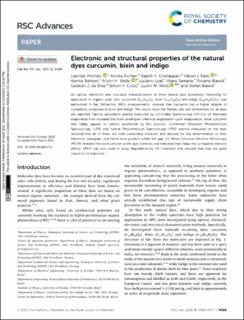| dc.contributor.author | Michels, Leander | |
| dc.contributor.author | Richter, Annika | |
| dc.contributor.author | Chellappan, Rajesh Kumar | |
| dc.contributor.author | Røst, Håkon Ivarssønn | |
| dc.contributor.author | Behsen, Alenka Djarmila | |
| dc.contributor.author | Wells, Kristin Høydalsvik | |
| dc.contributor.author | Leal, Luciano | |
| dc.contributor.author | Santana, Vilany | |
| dc.contributor.author | Blawid, Rosana | |
| dc.contributor.author | da Silva, Geraldo J. | |
| dc.contributor.author | Cooil, Simon | |
| dc.contributor.author | Wells, Justin William | |
| dc.contributor.author | Blawid, Stefan | |
| dc.date.accessioned | 2022-02-11T12:59:01Z | |
| dc.date.available | 2022-02-11T12:59:01Z | |
| dc.date.created | 2021-07-30T11:39:53Z | |
| dc.date.issued | 2021 | |
| dc.identifier.citation | RSC Advances. 2021, 11 (23), 14169-14177. | en_US |
| dc.identifier.issn | 2046-2069 | |
| dc.identifier.uri | https://hdl.handle.net/11250/2978494 | |
| dc.description.abstract | An optical, electronic and structural characterisation of three natural dyes potentially interesting for application in organic solar cells, curcumin (C21H20O6), bixin (C25H30O4) and indigo (C16H10N2O2), was performed. X-Ray Diffraction (XRD) measurements, showed that curcumin has a higher degree of crystallinity compared to bixin and indigo. The results from the Pawley unit cell refinements for all dyes are reported. Optical absorption spectra measured by UV-Visible Spectroscopy (UV-Vis) on thermally evaporated films revealed that bixin undergoes chemical degradation upon evaporation, while curcumin and indigo appear to remain unaffected by this process. Combined Ultraviolet Photoemission Spectroscopy (UPS) and Inverse Photoemission Spectroscopy (IPES) spectra measured on the dyes revealed that all of them are hole-conducting materials and allowed for the determination of their electronic bandgaps, and Fermi level position within the gap. UV Photo-Emission Electron Microscopy (PEEM) revealed the workfunction of the dye materials and indicated that indigo has a negative electron affinity. PEEM was also used to study degradation by UV irradiation and showed that they are quite robust to UV exposure. | en_US |
| dc.language.iso | eng | en_US |
| dc.publisher | Royal Society of Chemistry | en_US |
| dc.rights | Navngivelse 4.0 Internasjonal | * |
| dc.rights.uri | http://creativecommons.org/licenses/by/4.0/deed.no | * |
| dc.subject | Fysikalsk organisk kjemi | en_US |
| dc.subject | Physical organic chemistry | en_US |
| dc.subject | Solceller | en_US |
| dc.subject | Solar cells | en_US |
| dc.title | Electronic and structural properties of the natural dyes curcumin, bixin and indigo | en_US |
| dc.type | Peer reviewed | en_US |
| dc.type | Journal article | en_US |
| dc.description.version | publishedVersion | en_US |
| dc.subject.nsi | VDP::Organisk kjemi: 441 | en_US |
| dc.subject.nsi | VDP::Organic chemistry: 441 | en_US |
| dc.subject.nsi | VDP::Organisk kjemi: 441 | en_US |
| dc.subject.nsi | VDP::Organic chemistry: 441 | en_US |
| dc.source.pagenumber | 14169-14177 | en_US |
| dc.source.volume | 11 | en_US |
| dc.source.journal | RSC Advances | en_US |
| dc.source.issue | 23 | en_US |
| dc.identifier.doi | 10.1039/d0ra08474c | |
| dc.identifier.cristin | 1923136 | |
| dc.relation.project | Norges forskningsråd: 262633 | en_US |
| cristin.ispublished | true | |
| cristin.fulltext | original | |
| cristin.qualitycode | 1 | |

